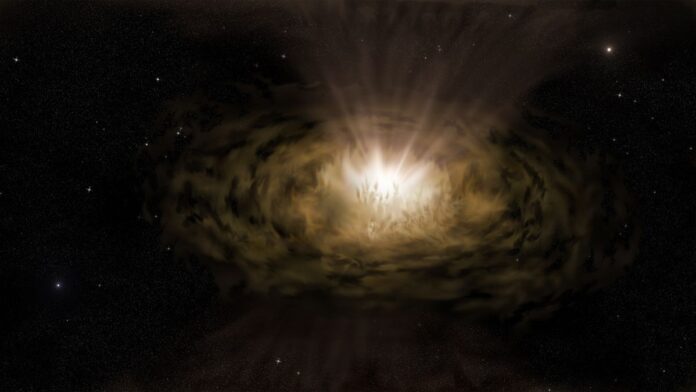Black holes residing at the center of galaxies produce way more energy than scientists previously thought, a new study has revealed.
These so-called active galactic nuclei devour huge amounts of matter, releasing massive amounts of energy in the form of electromagnetic radiation in the process. Scientists have known that these black-hole-powered active galactic centers produce more radiation than all the stars combined that inhabit the galaxies that surround them. Now astronomers have found that the amount of this radiation, or light, that these central black holes exude, could be about ten times larger than previously estimated.
The researchers reached this conclusion by calculating how much of the ultraviolet light coming from these black holes gets absorbed by the dust that surrounds them. It was a known fact that this dust reduces the amount of radiation from the active galactic nuclei that astronomers can detect, but there has not been agreement on how big this dimming effect could be.
Related: 15 times black holes surprised us in 2022
A team from the University of California Santa Cruz managed to answer this question by analyzing in detail the dimming effect of the dust surrounding one of the brightest known active galactic black holes, one found inside the galaxy known as NGC 5548 located some 245 million light-years away from Earth.
“When there are intervening small particles along our line of sight, this makes things behind them look dimmer,” Martin Gaskell, a research associate in astronomy and astrophysics at University California Santa Cruz and lead author of the paper, said in a statement (opens in new tab). “We see this at sunset on any clear day when the sun looks fainter.”
The dimming of the evening sun and the reddening of the solar disk both have the same cause. The same effect applies to the distant galactic centers, which appear redder than they actually are. In the case of the sun, however, astronomers can easily compare the dimmed light with the actual wavelength composition of the sun’s radiation and its intensity. To do the same for distant galaxies is much more complicated, as estimates of the intensity of the various wavelength components of undimmed radiation from distant active galactic nuclei are mostly based on theoretical predictions. Astronomers also weren’t sure whether different active galactic centers could be emitting different amounts of radiation at different wavelengths because of some fundamental differences between them.
In the new study, the team led by Gaskell used seven different indicators to estimate the amount of dust that obscures the center of NGC 5548, and found them “all to be in good agreement,” according to the statement. The dimming they found was considerable when looking out at NGC 5548, over ten times more significant than what astronomers experience due to the dust in our own galaxy, the Milky Way..
“[The result] strongly supports simple theories of emission from active galactic nuclei,” said Gaskell. “Exotic explanations of colors are not needed. This makes life simpler for researchers and is speeding up our understanding of what happens as black holes swallow material.”
The study (opens in new tab) was published in the journal Monthly Notices of the Royal Astronomical Society.
Follow Tereza Pultarova on Twitter @TerezaPultarova. Follow us on Twitter @Spacedotcom and on Facebook.

